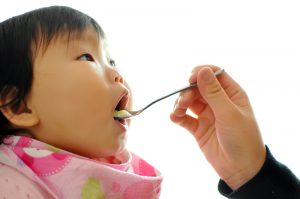First Foods Around the World
 What did you give your little one for his / her first meal? Pureed fruits? Vegetables? Meat? Oats?
What did you give your little one for his / her first meal? Pureed fruits? Vegetables? Meat? Oats?
And WHEN did you give it to them? Was Daddy there, too? Grandma? Auntie?
It’s a big decision isn’t it? A huge parenting milestone. Not to mention adorable / hysterical when it comes to the faces babies will pull when they try new flavors and textures for the first time. Trust us, if you are about to start weaning, get the camera ready!
While here in the US, it’s widely encouraged to breastfeed up to six months before introducing food, it is not the case for other countries and different cultures. It varies so much around the world– and it’s FASCINATING!
Did you know for example that a Tibetan baby’s first interaction with food is at FOUR days old? A piece of zamba – a mix of barley, wheat, corn, and peas, stirred, fried, ground in to flour and mixed with yak butter – is stuck to the baby’s forehead in a purity ritual.
Japanese parents start ahead of our six month recommendation too. Usually on the 100th day of the child’s life. At this stage, babies will often be presented with a dish called okayu, a rice porridge topped with dried fish and vegetables or mashed pumpkin.
In China, babies at four months will typically have moved on from breast milk to rice dishes paired with fish, carrots, seaweed, and eggs as well as blends such as chicken soup, pumpkin, ground pork and smashed eggplant. Jamaican parents often start at the four month mark too. Before morning milk, babies are given indigenous fruit blends – custard apple, mango, banana, papaya, naseberry – with honey.
And what about spices? When would you introduce those in to your baby’s diet? In India, at six months old, babies are introduced to khichidi – a vegetarian dish of rice and high protein lentils loaded with herbs and spices like cumin, cilantro, mint and cinnamon. Mexican parents also commonly opt to introduce spice young, sprinkling chili powder and lime on to apples, oranges and pears for baby.
Thought provoking isn’t it? What a colorful variety of dishes for the littles of the world!
Feeling emotional about weaning?
While babies of the world all eat differently, it is important to remember that all parents react to weaning differently too. While for some it is fun and exciting, it’s not unusual for others to have sad or uneasy feelings about this chapter.
There’s the ‘my baby is growing up so fast’ tears and anxieties about choking or allergies. As well as a sense of loss for many mothers who have breastfed and enjoyed that special ‘oneness’ with their child.
Some breastfeeding mothers even experience mood changes, which many researchers believe is down to hormones, because weaning brings with it a drop in prolactin and oxytocin levels. Prolactin, as well as being the hormone required for milk production, also promotes well-being, calmness and relaxation. Oxytocin, the hormone in charge of milk ejection, is also known as the ‘love hormone.’ When feeding decreases, or stops, so does the ‘feel good’ oxytocin.
Thankfully more and more research is being done into post-weaning depression. Support and awareness is growing. So remember, if you or someone you know has symptoms for longer than a few weeks, it’s important you speak with a doctor.
If you are interested in reading more about weaning around the globe, you can find the source of this article here.






